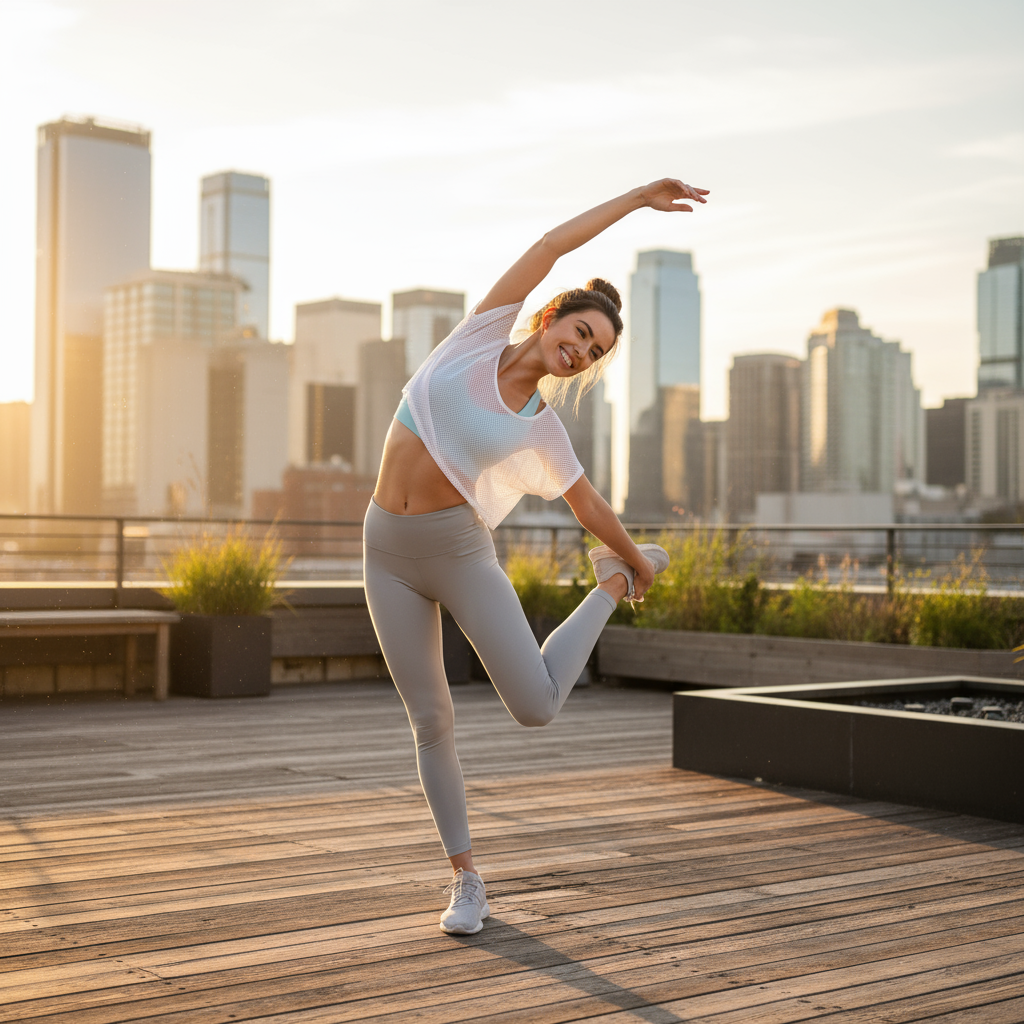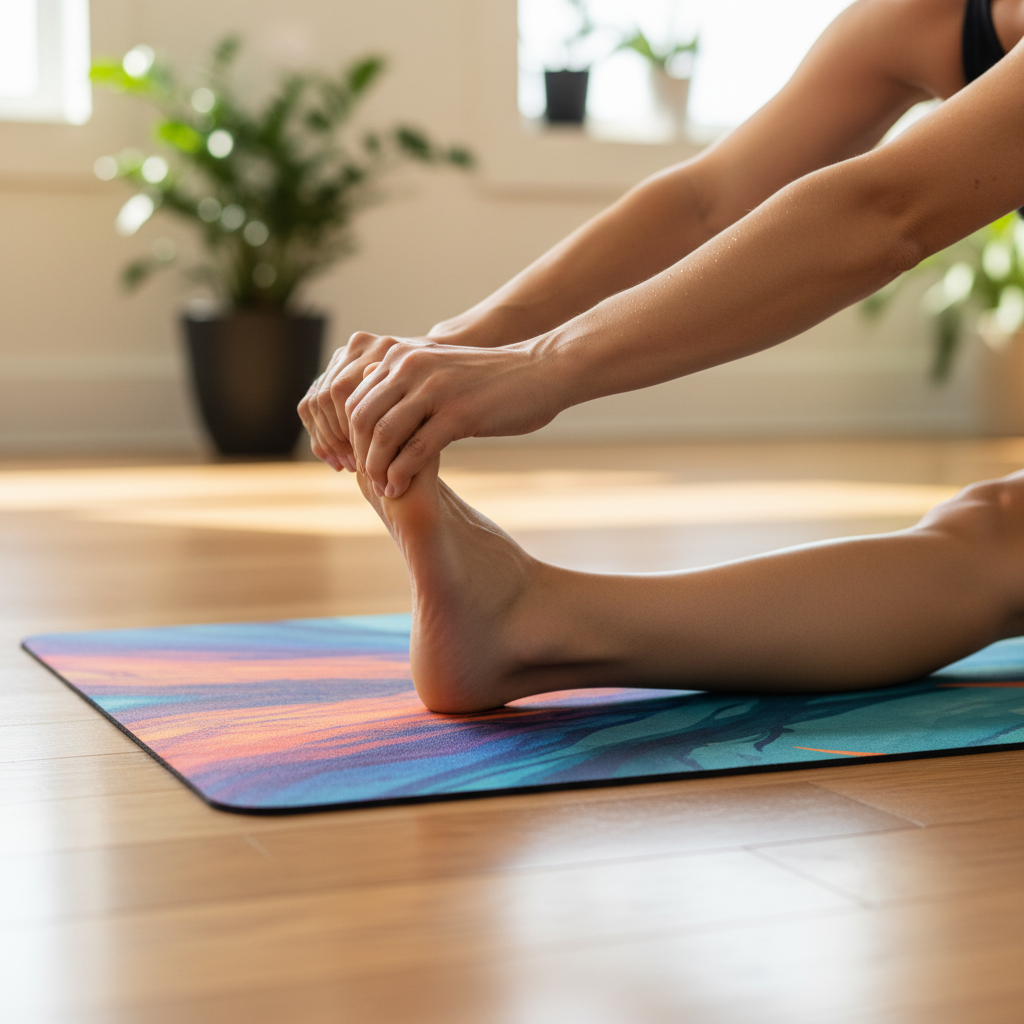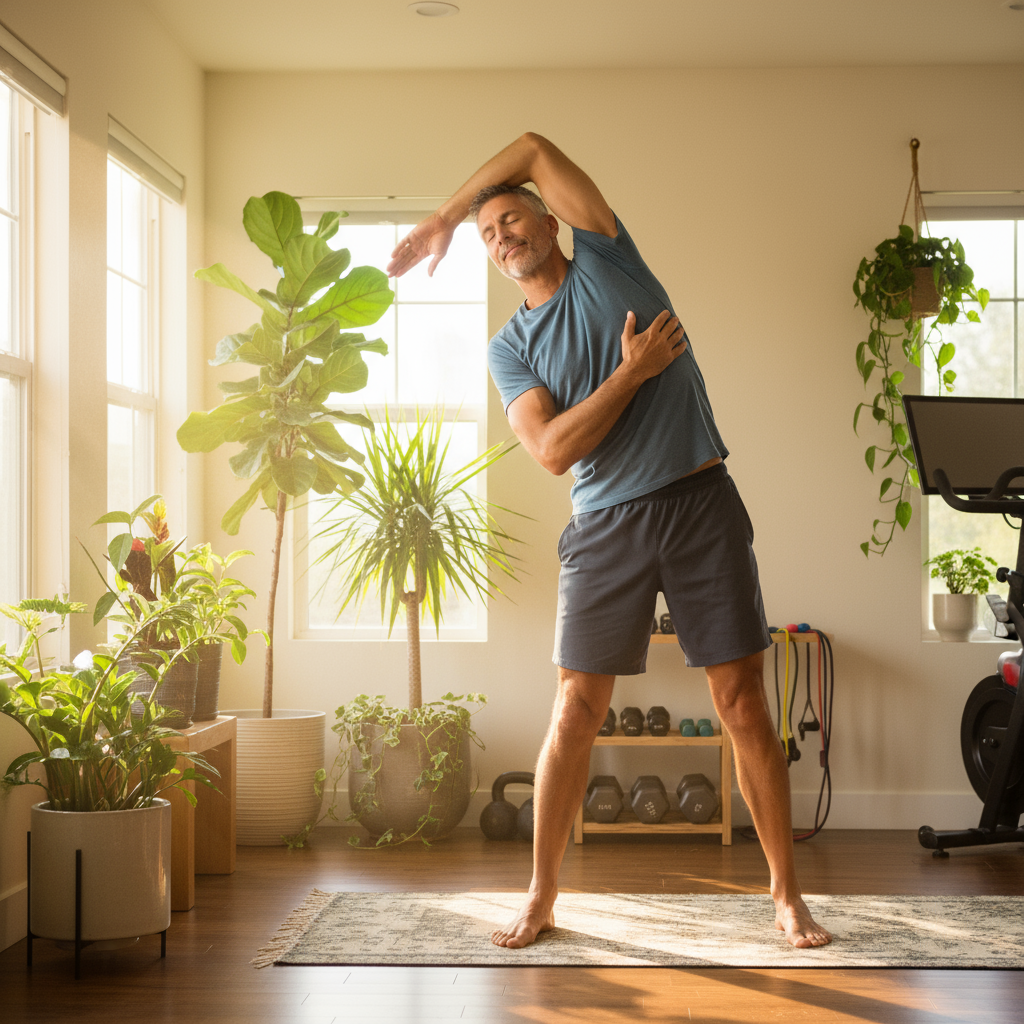
Table of Contents
Introduction
Here’s something most people don’t realize: just ten minutes of stretching each morning can completely change how your day feels. Picture this—you wake up, your body actually moves without creaking like an old door, and you feel genuinely ready for whatever life throws at you. That’s the power of daily stretching, and honestly? It’s one of the simplest wellness habits you can adopt.
Now, when I say flexibility, I’m not talking about becoming a pretzel or nailing those Instagram-worthy yoga poses (though kudos if that’s your thing). We’re talking about something much more practical—being able to reach for something on a high shelf without wincing, or getting out of bed without feeling like you aged twenty years overnight. Fitness experts have been saying this for years: regular stretching improves your range of motion and melts away muscle tension. And if you’re just starting your wellness journey, understanding how to start a fitness routine means recognizing that stretching isn’t just a nice-to-have—it’s essential.
But here’s where it gets really interesting. Stretching doesn’t just help your body; it’s like hitting a reset button for your mind too. When you stretch, you’re giving yourself permission to slow down, breathe, and actually be present. Combine that with regular physical activity, and you’ve got a recipe for feeling more focused and less frazzled throughout your day. (Trust me, your stress levels will thank you.) If you’re looking for a gentle way to ease into fitness, there are some fantastic fitness challenges for beginners that weave stretching right into the mix.
Let’s be real though—the thought of adding another thing to your daily routine might feel overwhelming. Maybe you’re worried about doing it wrong, or you’ve heard horror stories about people pulling muscles while stretching. Valid concerns! The good news? Most stretching mistakes are easily avoidable once you know what to watch for. Things like bouncing during stretches or pushing too hard too fast—we’ll cover all of that. And if motivation is your biggest hurdle (because let’s face it, staying consistent is tough), learning how to stay motivated to exercise will be your secret weapon for making stretching stick.
What You’ll Learn in This Guide
This guide is everything you need to build a stretching routine that actually works for your life. Whether you’re a complete beginner or someone who’s tried stretching before but couldn’t make it stick, we’ve got you covered.
- Understanding the Basics: We’ll break down what daily stretching really means, why your body craves it, and how those few minutes can become your favorite part of the day (seriously!).
- Benefits of Regular Stretching: From better flexibility and improved posture to a clearer mind and better mood—you’ll discover why stretching is like a daily vitamin for your entire well-being.
- Designing Your Routine: No cookie-cutter approaches here. We’ll help you create a stretching plan that fits your schedule, your fitness level, and your goals—whether you have five minutes or fifty.
- Maximizing Effectiveness and Safety: Learn the do’s and don’ts that keep stretching safe and effective, plus when it’s time to call in a professional if something doesn’t feel right.
What’s coming up next? We’re going to walk through exactly how to weave stretching into your daily life without it feeling like a chore. You’ll get sample routines for every fitness level, real-world tips for staying consistent (even on those crazy busy days), and clear guidance on when to seek help if you’re dealing with pain or specific limitations. Think of this as your roadmap to feeling more flexible and vibrant, step by simple step.
By the time you finish this guide, stretching won’t just be something you know you “should” do—it’ll be something you genuinely look forward to. You’ll move better, feel less stressed, and have a daily practice that grounds you no matter what chaos surrounds you. Plus, you’ll have the confidence to listen to your body and adjust your routine as needed.
Ready to discover what your body can feel like when you give it the gentle attention it deserves? Let’s dive in and make flexibility a cornerstone of your wellness journey.

Here’s something most people don’t realize about stretching: it’s not just about touching your toes or doing a quick hamstring pull after a workout. Daily stretching? It’s actually one of the simplest ways to transform how your body feels and moves—and honestly, how your mind handles stress too. When you make stretching a regular part of your day, you’re setting yourself up for benefits that go way beyond just being more flexible. We’re talking better posture, less pain, improved mood, and even better sleep. Sounds pretty good, right?
Understanding Daily Stretching and Its Benefits
Let’s get one thing straight—daily stretching isn’t just some trendy wellness hack. It’s a game-changer for how your body functions and how you feel mentally. Think about it: when you gently stretch your muscles and connective tissues, you’re basically giving your body a reset. Your joints move better, your muscles stay loose, and everyday activities (like reaching for something on a high shelf or bending down to tie your shoes) become effortless instead of painful.
But here’s where it gets really interesting. Stretching isn’t just physical therapy for your muscles—it’s therapy for your mind too. When you focus on your breath and really tune into your body during a stretch, something magical happens. Your stress melts away. Your mind quiets down. It’s like hitting the pause button on life’s chaos and giving yourself permission to just… breathe. No wonder so many people swear by their morning or evening stretch routines.
Key Aspects of Daily Stretching Benefits
Ready to see why stretching deserves a spot in your daily routine? Here’s what happens when you commit to regular stretching:
- Improved flexibility and range of motion: Your muscles stay elastic and your joints keep their full range of movement. This isn’t just about looking good in yoga class—it’s about preventing injuries and moving through life with ease. Want to speed up your progress? Check out our guide on how to increase flexibility fast.
- Reduced muscle tension and soreness: Ever feel like your shoulders are permanently hunched or your lower back is constantly tight? Stretching increases blood flow to those problem areas, helping muscles relax and recover faster. It’s like giving yourself a mini massage every day.
- Enhanced circulation and posture: Better blood flow means your tissues get the nutrients they need to stay healthy. Plus, when your muscles are balanced and flexible, you naturally stand taller and sit straighter. Your spine will thank you.
- Stress relief and relaxation: This is where the magic really happens. Stretching activates your body’s “rest and digest” mode, switching you from fight-or-flight stress to calm-and-collected relaxation. The result? Better sleep and a more peaceful mind.
- Improved focus and mood: When you combine movement with mindful breathing, you’re basically meditating in motion. Your anxiety drops, your mood lifts, and your mind feels clearer. It’s amazing what 10 minutes of stretching can do for your entire day.
Once you experience these benefits firsthand (and trust me, you will), creating a structured routine becomes the natural next step. Because here’s the thing—random stretching is good, but strategic stretching? That’s where you’ll see real transformation.
Creating and Optimizing a Daily Stretching Routine
So you’re sold on the benefits, but now you’re probably wondering: “How do I actually build a stretching routine that works?” Good question. The key is finding that sweet spot between structure and flexibility (pun intended). You want a routine that hits all the major muscle groups, fits into your schedule, and—this is crucial—feels sustainable. Nobody wants a stretching routine that feels like a chore.
The secret sauce? Start with the basics and gradually add layers. Think warm-up first, then a variety of stretches that target your trouble spots, and always finish with some mindful breathing. Oh, and don’t forget about props—they’re not cheating, they’re smart tools that help you stretch safer and deeper.
Key Components of an Effective Stretching Routine
Let’s break down what makes a stretching routine actually work:
- Warm-up techniques before stretching: Never stretch cold muscles—that’s asking for trouble. Start with 5-10 minutes of light movement like walking or gentle arm circles. This preps your body for deeper stretches and keeps you injury-free. This approach aligns perfectly with the principles we discuss in our functional fitness workouts guide.
- Variety of stretches targeting major muscle groups: Don’t play favorites with your muscles. Your neck, shoulders, back, hips, hamstrings, and calves all deserve attention. A well-rounded routine ensures no area gets left behind—because that forgotten muscle group will definitely remind you later.
- Duration and frequency recommendations: Here’s a simple rule: hold each stretch for 15-60 seconds and repeat 2-4 times. Aim for daily stretching if possible, but even 3-5 times a week will make a noticeable difference. Consistency beats intensity every time.
- Incorporating breathing and mindfulness: This is where stretching becomes more than just physical exercise. Deep, slow breaths during each stretch boost relaxation, improve oxygen flow, and turn your routine into a moving meditation. Your body and mind will both feel the difference.
Starting out? Keep it simple. A basic routine might include seated neck rolls, standing hamstring stretches, chest openers against a wall, and gentle spinal twists. As you get more comfortable and flexible, you can add complexity and hold stretches longer.
Maximizing Effectiveness and Avoiding Mistakes
Want to get the most out of your stretching routine while staying safe? Here’s what you need to know:
- Avoid overstretching and improper form: Stretching should feel like a gentle pull, not sharp pain. If it hurts, back off. Your body knows the difference between “good stretch” and “potential injury.” For guidance on safe techniques, our best post-workout stretches guide can help you maintain proper form.
- Listen to your body and allow rest: Some days your body will feel tight, other days more open. Honor where you are instead of forcing it. And yes, rest days are important—even for stretching. Your muscles need time to adapt and recover.
- Use props or tools to assist stretches: Yoga blocks, straps, and resistance bands aren’t just for yoga studios. They help you stretch more effectively and safely, especially when you’re working on flexibility. Think of them as your stretching assistants.
- Consistently integrate mindfulness and breathing: Never underestimate the power of focused breathing. It’s what transforms a simple stretch into a stress-busting, mood-boosting experience. Make every breath count.
When you put all these pieces together—proper warm-up, varied stretches, mindful breathing, and smart safety practices—you’re not just stretching. You’re investing in a daily practice that will pay dividends in how you feel, move, and handle life’s stresses. And the best part? You can start today, right where you are.

Here’s what I love about daily stretching—it gives you so much more than just flexibility. Sure, you’ll notice your range of motion improving and those tight muscles finally relaxing. But the real magic happens when you realize how much better you feel overall. Your posture straightens up, blood flows better, and that nagging tension you carry around? It starts melting away. And here’s the bonus: those few minutes of gentle mindfulness become your daily reset button, washing away stress and sharpening your focus. It’s like giving your body and mind a mini-vacation every single day.
The secret sauce? Consistency. (I know, I know—everyone says that.) But honestly, even 10 minutes daily beats an hour-long session once a week. Think of it this way: your muscles are like that friend who needs regular check-ins to stay happy. Skip too many days, and they’ll remind you with stiffness and complaints. When you show up consistently with proper technique and mindful breathing, something beautiful happens. Your body starts trusting the process, injuries become less likely, and you develop this calming ritual that helps you handle whatever craziness life throws at you. Whether you’re prepping for a tough workout or just trying to get through Monday morning meetings, stretching sets you up for success.
Ready to take things up a notch? Your newfound flexibility is begging for some strength to back it up. That’s where functional fitness workouts come in—they’ll build the kind of strength that actually supports your daily movements. And when you’re done pushing yourself, don’t skip the cool-down. Our guide to best post-workout stretches will keep your muscles happy and help you recover faster. The biggest challenge? Staying motivated when the novelty wears off. We’ve got your back with proven strategies in how to stay motivated to exercise that actually work long-term.
Want to really treat your muscles right? Add some foam rolling into the mix. Our breakdown of the benefits of foam rolling will show you how to work out those knots and boost your mobility safely. Plus, if you’re serious about improving your posture (and let’s face it, most of us need help there), check out how to improve core stability. These pieces work together like a well-oiled machine, keeping you balanced and injury-free.
But here’s something people often overlook—your mind and body are a team. The mental health benefits of exercise are just as important as the physical ones, especially when you’re dealing with stress or feeling down. And let’s talk fuel: all this movement means your body needs quality nutrition to keep up. Smart meal planning tips will ensure you’re giving your muscles what they need to recover and your energy levels stay steady throughout the day.
Look, starting a daily stretching routine is one of the kindest things you can do for yourself. It’s not about becoming a contortionist overnight or forcing your body into pretzel shapes. It’s about showing up, listening to what your body needs, and giving it a few minutes of care each day. Every gentle stretch is an investment in how you’ll feel tomorrow, next month, and years down the road. Trust the process, be patient with yourself, and remember—small, consistent efforts create the biggest transformations. Your future self will thank you for starting today.
Frequently Asked Questions
-
How long should a daily stretching routine last?
- Most daily stretching sessions range from 5 to 20 minutes, depending on your fitness level and available time. The key is consistency rather than duration.
-
Is it better to stretch in the morning or evening?
- Both times offer benefits: morning stretches help awaken muscles and prepare the body for the day, while evening stretching promotes relaxation and aids restful sleep.
-
Can stretching prevent injuries?
- Yes, regular stretching improves flexibility and muscle balance, which can reduce the risk of strains and other common injuries during physical activities.
-
What should I do if I feel pain during stretching?
- Stop immediately to avoid injury. If pain persists, consult a healthcare or fitness professional for evaluation and guidance on proper techniques.
-
Can I combine stretching with other forms of exercise?
- Absolutely, stretching complements most fitness routines such as strength training, cardio, yoga, and functional workouts, enhancing overall performance and recovery.
